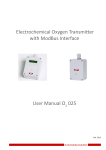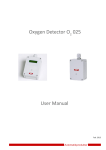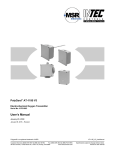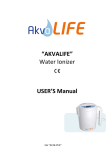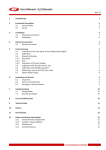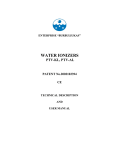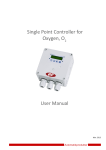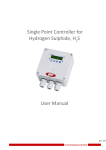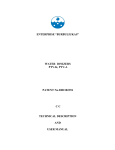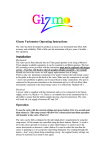Download Electrochemical Oxygen Transmitter LO , MO User Manual
Transcript
Electrochemical Oxygen Transmitter LO2, MO2 User Manual Feb. 2013 Automatikprodukter Electrochemical Oxygen Transmitter - LO2, MO2 Feb. 13 Table of contents 1 General overview.............................................................................................................................................. 3 2 Functional Description....................................................................................................................................... 3 3 Installation ....................................................................................................................................................... 4 3.1 Mounting Instructions ...................................................................................................................................... 4 3.2 Installation . ....................................................................................................................................................... 4 4 Electrical Connection........................................................................................................................................ 5 4.1 Wiring Connection . ........................................................................................................................................... 5 4.2 Output Signal...................................................................................................................................................... 5 5 Commissioning . .............................................................................................................................................. 6 5.1 Calibration Zero Point (Output Signal 4 mA)...................................................................................................... 6 5.2 Calibration Span................................................................................................................................................. 6 5.3 Calculation of Control Span Voltage................................................................................................................... 7 6 Inspection and Service...................................................................................................................................... 8 6.1 Inspection........................................................................................................................................................... 8 6.2 Service and Calibration....................................................................................................................................... 8 6.3 Exchange of Sensor Element.............................................................................................................................. 8 7 Troubleshooting................................................................................................................................................ 9 7.1 Diagnostics at the transmitter............................................................................................................................ 9 8 Cross-sensitivity Data........................................................................................................................................ 9 9 Specifications.................................................................................................................................................. 10 10 Calibration Adapter....................................................................................................................................... 11 11 Spare Parts List.............................................................................................................................................. 11 12 Part Disposal................................................................................................................................................. 11 13 Notes and General Information..................................................................................................................... 12 13.1 Intended Product Application........................................................................................................................ 12 13.2 Installers` Responsibilities.............................................................................................................................. 12 13.3 Maintenance.................................................................................................................................................. 12 13.4 Limited Warranty............................................................................................................................................ 12 14 Appendex Enclosure A and 5......................................................................................................................... 14 14.1 Enclosure Type A............................................................................................................................................ 14 14.2 Enclosure Type 5............................................................................................................................................ 14 14.3 Installation Work............................................................................................................................................ 15 14.4 Connection Work............................................................................................................................................ 15 14.5 Calibration...................................................................................................................................................... 15 14.6 Specifications................................................................................................................................................. 15 14.7 Exchange of Sensor Element.......................................................................................................................... 16 14.8 Opening of the Enclosure Type 5................................................................................................................... 16 2 Automatikprodukter Electrochemical Oxygen Transmitter - LO2, MO2 Feb. 13 1 General overview The O2 analog transmitter with 4 – 20 mA / 2- 10 V output is used for the continuous monitoring to detect the presence of oxygen concentrations in the ambient air. Main application ranges are laboratories, food production etc. with the possibility to change the oxygen content. The intended sites within the ambient conditions defined in the Specifications are all areas being directly connected to the public low voltage supply, e.g. residential, commercial and industrial ranges as well as small enterprises (according to EN50 082). The transmitter must not be used in potentially explosive atmospheres. 2 Functional Description The chemical process of the measurement is based on the principle of a galvanic micro-fuel cell. The gas or the ambient air to be monitored diffuses through a membrane filter into the measuring cell towards the cathode. Cathode and anode are electrically contacted, therefore due to the oxidation there is an electric current proportional to the oxygen partial pressure. This current signal is linear to the oxygen concentration. The current is evaluated by the connected amplifier and transformed into a linear output signal. The diffusion through the membrane and the thin electrolytic coat are complex, temperature dependant, electrochemical processes influencing the ion current of the sensor. Therefore the sensor is temperature-compensated within the specified temperature range. The electrolyte, the catholyte and the composition of the anode are designed in a way that the oxygen diffusing towards the cathode is electrochemically reduced. The electrolyte is used up by the electrochemical process. So the sensor life time is limited to two years. Calibration during sensor life time is not necessary. • There is a small quantity of corrosive liquid in the sensor element. If in case of damage persons or objects touch the liquid, you have to clean the affected areas as fast and carefully as possible with tap water. Out of use sensors must be disposed in the same way as batteries. • Silicon leads to an undesirable chemical reaction in the sensor and so causes a drift of the zero-point to the positive side. Prolonged exposure leads to an important reduction of the sensor sensibility. After exposure to silicone the sensor has to be replaced in order to provide for the functional reliability furthermore. • Electronics can be destroyed by static electricity. Therefore, do not touch the equipment without a wrist strap connected to ground or without standing on a conductive floor (acc. to EN 61340-5-1). 3 Automatikprodukter Electrochemical Oxygen Transmitter - LO2, MO2 Feb. 13 3 Installation 3.1 Mounting Instructions When choosing the mounting site please pay attention to the following: • The specific weight of oxygen O2 is higher than that of air (factor 1.10). Recommended mounting height is 1.5 m (5 feet) to 1.8 m (6 feet) above floor for combustial applications. • Consider the ventilation conditions! Do not mount the transmitter in the centre of the airflow (air passages, suction holes). • Mount the transmitter at a location with minimum vibration and minimum variation in temperature (avoid direct sunlight). • Avoid locations where water, oil etc. may influence proper operation and where mechanical damage might be possible. • Provide adequate space around the sensor for maintenance and calibration work. 3.2 Installation • Open cover of enclosure. • Fix the enclosure by the 2 screws (gas inlet to the ground). • Replace the cover. 79 Mounting 50 50mm Mounting Gas inlet “DOWN” Gas inlet “DOWN” 1500 - 1800 mm Zero Gain Test Zero Gain Test Gas inlet: Prior to commissioning, cut protective cap carefully off with a knife. 4 Automatikprodukter Electrochemical Oxygen Transmitter - LO2, MO2 Feb. 13 4 Electrical Connection Installation of the electrical wiring should only be performed by a trained specialist according to the connection diagram, without any power applied to conductors and according to the corresponding regulations! Avoid any influence of external interference by using a shielded cable. Recommended cable: J-Y(St)Y 2x2x0.8LG (18 AWG), maximum resistance 73 Ω/1000 m (20.8 Ω/1000 ft) When the PCB is mounted, it is important to ensure that the wire shields or any bare wires do not short the PCB. 4.1 Wiring Connection • Open cover of enclosure. • Insert cable and strip it off. • Remove triple-pole socket board and connect the cable according to the wiring diagram. • Replug the socket board correctly at the multi-pin connector. • Close the cover. 24 VDC 2 - 10 V 0 VDC 24 VDC 4 - 20 mA 0 VDC 0 VDC 2 - 10 V 24 VDC 1 2 3 4 - 20 mA 24 VDC 1 2 3 Controller Transmitter MA-11XX Controller Transmitter MA-11XX Operation mode 4 - 20 mA Operation mode 2 - 10 V Fig. 2 Wiring Diagram Gain Zero 1 2 3 Gain Zero Gain Zero Test Zero Gain Zero Gain 3 2 1 Test 3 2 1 Fig. 3 Electric connection 4.2 Output Signal Operation mode 4- 20 mA: The transmitter is always current source. Only 2-wire connection. Gain Zero Operation mode 2 – 10 V: Remove R40 by using a wire cutter. Always 3-wire connection. R 40 Test 1 2 3 Fig. 4 Board 5 Automatikprodukter Electrochemical Oxygen Transmitter - LO2, MO2 Feb. 13 5 Commissioning Please observe proper handling procedures for test gas bottles and the regulations according to TRGS 220! • Prior to calibration the sensor element must be powered and fully stabilized for at least 1 hour without interruption. • Calibration must only be performed under operation typical ambient conditions. Always consider the commissioning instructions when exchanging the sensor element. Only trained technicians should perform the following: • Cut the protective cap at the gas inlet carefully off by using a knife (only for enclosure D / F). See fig.1. • Check mounting location. • Check power voltage. • Calibrate the transmitter (if not factory calibrated). Required instruments to commission/ calibrate the transmitter: • Test gas bottle with test gas O2 with 20.9 vol.% or with ambient air 20.9 vol.% O2. • Gas pressure regulator with flow meter. • Calibration adapter with tubing. Type: XXXXX See Fig. 6. • Digital voltmeter with range 0 – 10 VDC, accuracy 1% • Small screwdriver. 5.1 Calibration Zero Point (Output Signal 4 mA) • The zero point is factory-calibrated. Further zero calibration is not necessary. 5.2 Calibration Span • Connect calibration adapter to the sensor element. • Connect digital voltmeter to pin “Test”. • Apply test gas O2, 150 ml/min; 1 Bar (14.5 psi). • Wait two minutes until the signal is stable, adjust signal with potentiometer ”Gain” until the signal corresponds to the calculated value, see calculation for control voltage. At a loss of sensitivity of more than 70% caused by ageing, operational or climatic influences, calibration will not be possible any more. Then the sensor has to be replaced. 6 Automatikprodukter Electrochemical Oxygen Transmitter - LO2, MO2 Feb. 13 5.3 Calculation of Control Span Voltage The control voltage at the pin “Test” simulates the 4 – 20 mA signal at a 10 Ohm measuring resistance. Control span voltage (mV) = 160 (mV) x test gas concentration O2 (vol. %) measuring range O2 (vol. %) + 40 (mV) Example: Measuring range Test gas concentration Control voltage: Signal start 2 V / 4 mA Control voltage: Signal start 0 V / 0 mA 160 (mV) x 20.9 (vol. %) 25 (vol. %) + 40 (mV) 25 vol. % 20,9 vol. % O2 173,7 mV 67,2 mV = 173.7 mV Control voltage mV Gain calibration = 160 (mV) x O2 (vol. %) Measuring range (vol. %) + 40 (mV) Flow rate: 150 ml/min ± 20 ml Zero Gain Pressure: 1 Bar ±10% Test Test gas: Gain calibration: O2 (vol %) with a concentration of 20,9 vol %. Fig. 5 Calibration 7 Automatikprodukter Electrochemical Oxygen Transmitter - LO2, MO2 Feb. 13 6 Inspection and Service Inspection, service and calibration of the transmitters should be done by trained technicians and executed at regular intervals. We therefore recommend concluding a service contract with Automatikprodukter or one of their authorized partners. According to EN 45544-4, inspection and service has to be executed at regular intervals. The maximum intervals have to be determined by the person responsible for the gas warning system according to the legal requirements. Automatikprodukter recommends checking the O2 transmitter every three months and maintaining it every 12 months. If different intervals are indicated, always consider the shortest interval. Inspections and services must be documented. The date for the next maintenance has to be affixed to the transmitter. 6.1 Inspection The O2 Transmitter should be controlled regularly by a competent person according to EN 45544-4. The following has to be checked in particular: • Maintenance/ calibration interval not exceeded. • Visual inspection of the transmitter including cable for damage etc. • Remove dust deposits, especially at the gas inlet. • For enclosure type A: The filter at the gas inlet has to be replaced if extremely dirty. 6.2 Service and Calibration When performing the maintenance you have to do the calibration and the functional test in addition to the inspection. • Calibration: See section 5. • Functional test: Check the output signal at the test pins during calibration 6.3 Exchange of Sensor Element Sensor should always be exchanged without power applied (remove the socket board): • Unscrew the two fixing bolts. • Remove the board with the sensor upwards out of the sensor cup. • Unplug old sensor element from the PCB, plug in new original sensor element. • Plug in the PCB with the sensor into sensor cup and tighten it by the screws. • Plug in the socket board correctly. See fig.3. • Calibrate the sensor (see section 5.). 8 Automatikprodukter Electrochemical Oxygen Transmitter - LO2, MO2 Feb. 13 7 Troubleshooting 7.1 Diagnostics at the transmitter Trouble Cause Output signal 0 mA and control volt- Power voltage not applied or not age 0 V connected correctly. Socket board not plugged in correctly Output signal < 3 mA and/or control Transmitter not calibrated voltage < 30 mV Control voltage doesn’t reach the Sensor sensitivity < 30 % calculated value Solution Measure power voltage at terminal block 1 (+) and 2 (-) (16 – 28 VDC) Plug in the socket board acc. to fig.3. Calibrate transmitter Replace sensor element If faults cannot be eliminated by the above mentioned actions or if other faults not described in this table occur, please contact the service 8 Cross-sensitivity Data See Specifications 9 Automatikprodukter Electrochemical Oxygen Transmitter - LO2, MO2 Feb. 13 9 Specifications Electrical Power supply Power consumption (without options) Sensor Performance Type of gas Sensor element Measuring range Accuracy Long term drift output Response time Sensor life expectancy Cross sensitivity Carbon dioxide, CO2 Mounting height Type of Control Analog output signal Operating Environment Humidity Working temperature Storage temperature Pressure range Physical characteristics Enclosure Enclosure material Flammability Enclosure colour Dimensions (W x H x D) Weight Protection class Mounting Cable entry Wire connection Wire distance Directives Warranty 16 - 28 VDC (reverse polarity protected), 2 - 10Vdc, 24Vac/dc 22 mA, (0.6 VA), max. Oxygen (O2) Electrochemical, diffusion 0 – 25 vol % ± 0,1 vol % < 4 % reading/year t90 ≤ 15 sec. 2 years, normal operating environment Concentration Reaction (vol % O2) 5 vol % 2 1.5 to 1.8 m (5 to 6 ft.) above floor for combustial applications 4 – 20 mA, load Ω 500 Ω 2 -10 V, load ≥ 50 k Ω Proportional, overload and short-circuit protected 0 to 90 % RH non-condensing -10 °C to + 50 °C (14 °F to 122 °F) + 5 °C to + 30 °C (41 °F to 86 °F) Atmospheric ±10% Type D Type F Polycarbonate GW Plast 75 GWT UL 94 V2 UL 94 V0 RAL 7032 (light grey) RAL 7032 (light grey) 94 x 65 x 57 mm Round: (d x H) 87 x 45.5 mm 0.3 kg 0.2 kg IP 43 IP 43 Wall mounting, pillar mounting 1 x M 20 Screw type terminal, min. 24 AWG (0.25 mm2), max. 14 AWG (2.5 mm2) Max. loop resist. 500 Ω (= wire resistor + controller input resistor) EMC Directive 2004/108/EEC EC One year material (without sensor) 10 Automatikprodukter Electrochemical Oxygen Transmitter - LO2, MO2 Feb. 13 10 Calibration Adapter Enclosure Type A and 5 Type: Calibr-set Fig. 6 Calibration Adapter 11 Spare Parts List Description Sensor PCB without sensor Connector triple-pole Order No. Sense09-1195 MA_25..600.2353.0 12 Part Disposal Since August 2005 there are EC-wide directives defined in the EC Directive 2002/96/EC and in national codes concerning the waste electrical and electronic equipment and also regarding this device. For private households there are special collecting and recycling possibilities. For this device isn’t registered for the use in private households, it mustn’t be disposed this way. You can send it back to your national sales organisation for disposal. If there are any questions concerning disposal please contact your national sales organisation. Outside the EC, you have to consider the corresponding directives. 11 Automatikprodukter Electrochemical Oxygen Transmitter - LO2, MO2 Feb. 13 13 Notes and General Information It is important to read this user manual thoroughly and clearly in order to understand the information and instructions. The O2 transmitters must be used within product specification capabilities. The appropriate operating and maintenance instructions and recommendations must be followed. Due to on-going product development, Automatikprodukter reserves the right to change specifications without notice. The information contained herein is based upon data considered to be accurate. However, no guarantee is expressed or implied regarding the accuracy of this data. 13.1 Intended Product Application The transmitters are designed and manufactured for control applications and air quality compliance in commercial buildings and manufacturing plants. 13.2 Installers` Responsibilities It is the installer’s responsibility to ensure that all transmitters are installed in compliance with all national and local codes and OSHA requirements. Installation should be implemented only by technicians familiar with proper installation techniques and with codes, standards and proper safety procedures for control installations and the latest edition of the National Electrical Code (ANSI/NFPA70). It is also essential to follow strictly all instructions as provided in the user manual. 13.3 Maintenance It is recommended to check the transmitter regularly. Due to regular maintenance any performance deviations may easily be corrected. Re-calibration and part replacement in the field may be implemented by a qualified technician and with the appropriate tools. Alternatively, the easily removable plug-in transmitter card with the sensor may be returned for service to Automatikprodukter. 13.4 Limited Warranty Automatikprodukter warrants the transmitters for a period of one (1) year from the date of shipment against defects in material or workmanship. Should any evidence of defects in material or workmanship occur during the warranty period, Automatikprodukter will repair or replace the product at their own discretion, without charge. This warranty does not apply to units that have been altered, had attempted repair, or been subject to abuse, accidental or otherwise. The warranty also does not apply to units in which the sensor element has been overexposed or gas poisoned. The above warranty is in lieu of all other express warranties, obligations or liabilities. This warranty applies only to the transmitter. Automatikprodukter shall not be liable for any incidental or consequential damages arising out of or related to the use of the O2 transmitters. 12 Automatikprodukter Electrochemical Oxygen Transmitter - LO2, MO2 Feb. 13 14 Appendex Enclosure A and 5 14.1 Enclosure Type A 115 mm Mounting 3 2 1 1500 - 1800 mm Zero Gain Test Fig.7 Enclosure type A Mounting 79 mm 14.2 Enclosure Type 5 Mounting d = 5 mm Mounting d = 5 mm 1500 - 1800 mm Fig.8 Enclosure type 5 Zero Gain Test 84 mm 3 2 1 13 Automatikprodukter Electrochemical Oxygen Transmitter - LO2, MO2 Feb. 13 14.3 Installation Work • Open cover. • Fix the enclosure by 2 screws (gas inlet always downwards). • Close cover. 14.4 Connection Work • Pay attention to the general information (section 4). • Open cover. • Insert cable, strip it off and connect it. • Close cover. 14.5 Calibration Flow rate: 150 ml/min ± 20 ml mV 3 2 1 Pressure: 1 Bar ±10% Zero Gain Test Fig.9 Calibration for enclosure types A and 5 15.6 Specifications Physical characteristics Enclosure Enclosure material Flammability Enclosure colour Dimensions (W x H x D) Weight Protection class Mounting Cable entry Type A Polycarbonate UL 94 V2 RAL 7032 (light grey) 94 x 130 x 57 mm 0.3 kg IP 65 Wall mounting, pillar mounting Standard 1 x M 20 Type 5 V2A, 1mm, material 1.4301 Natural, brushed 113 x135 x 45 mm 0.5 kg IP 55 14 Automatikprodukter Electrochemical Oxygen Transmitter - LO2, MO2 Feb. 13 15.7 Exchange of Sensor Element Sensor should always be exchanged without power applied (remove the PCB at the socket board): • Unplug old sensor element from the PCB, plug in new original sensor element. • Plug in the PCB at the socket board correctly. See fig.3. • Calibrate the sensor (see section 5.). 15.8 Opening of the Enclosure Type 5 Latching points of cover Side for opening Latching points of cover Direction of cover when opening Opening Fig. 10 Opening of the enclosure type 5 15 Automatikprodukter















